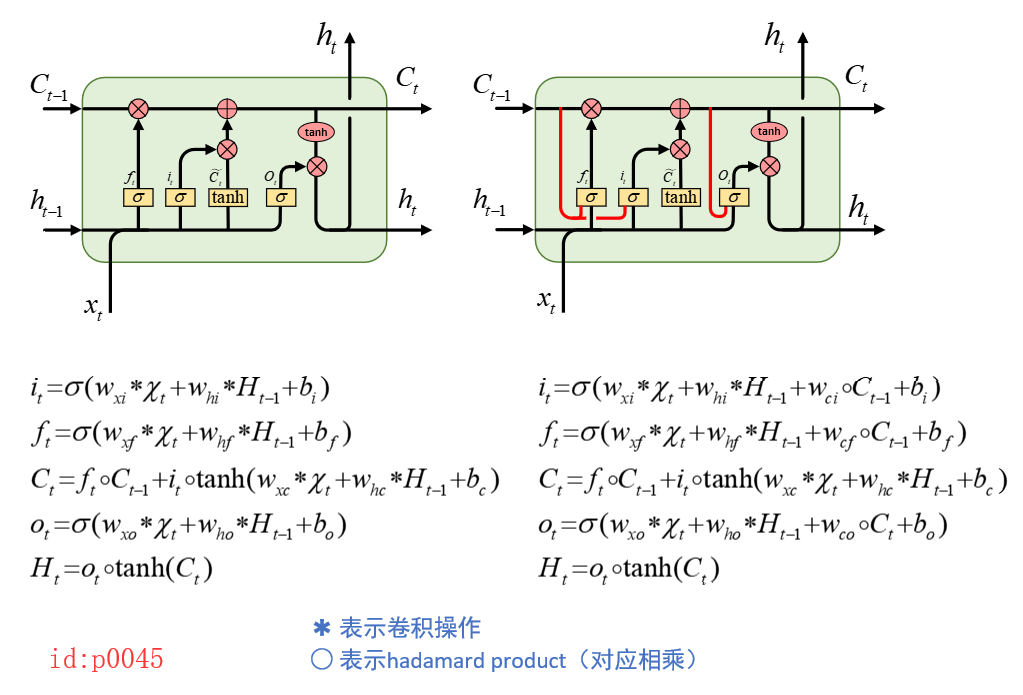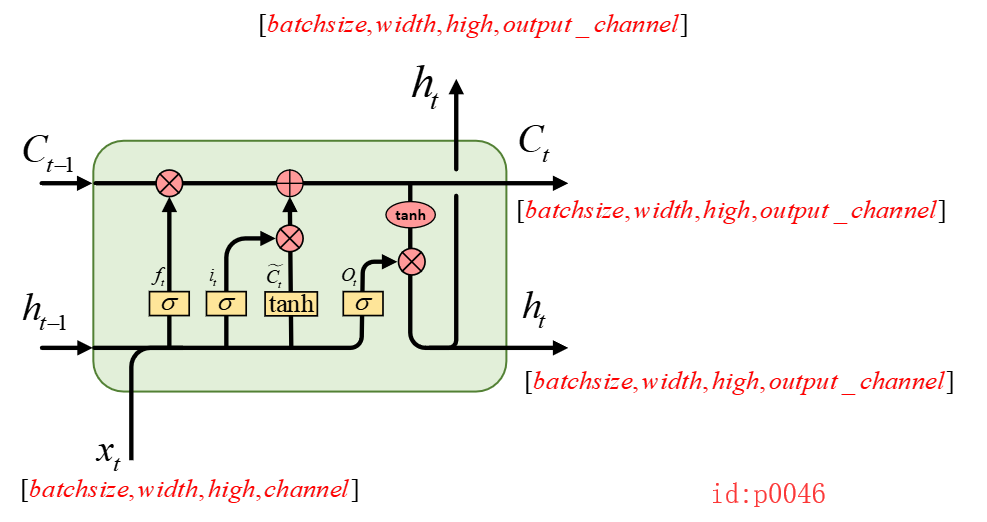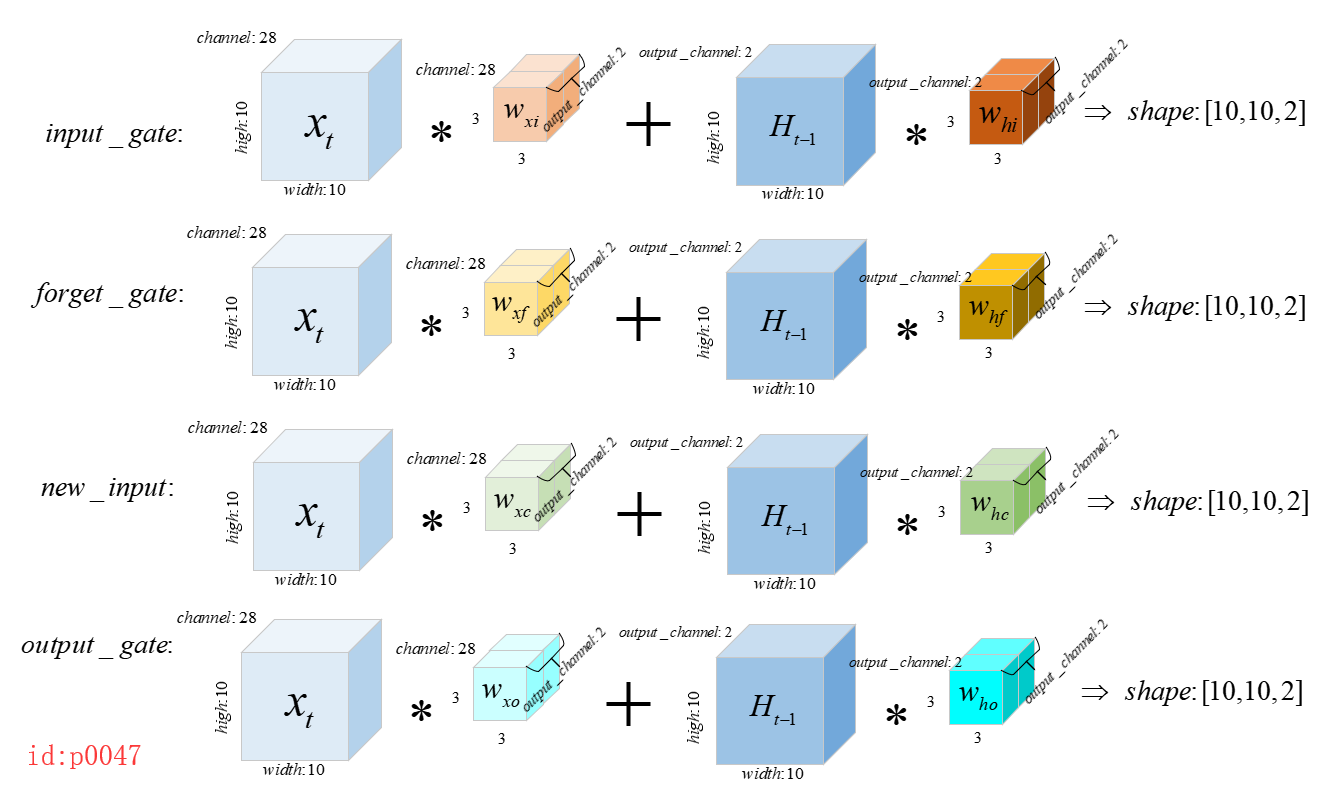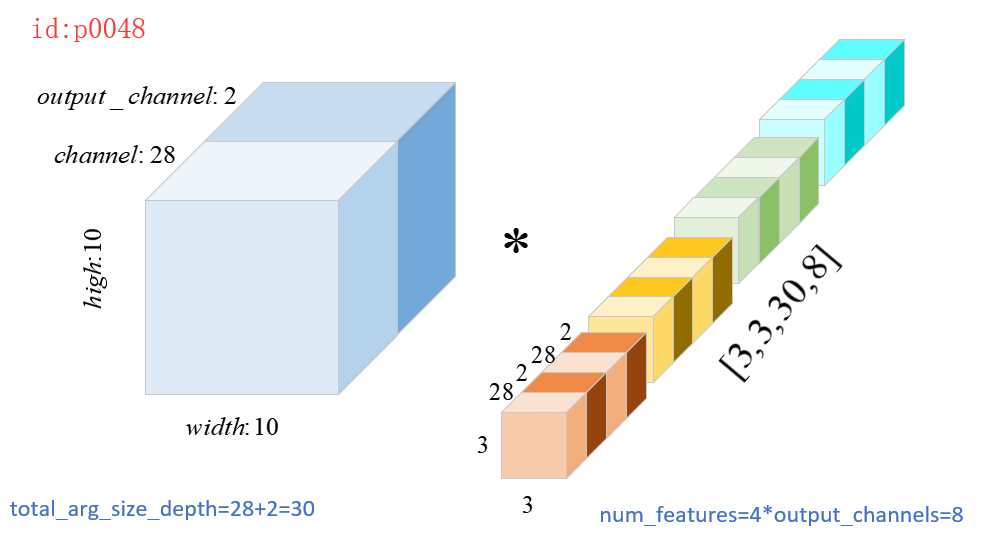迴圈神經網路系列(七)Tensorflow中ConvLSTMCell
前面一文我們簡單得介紹了ConvLSTM得原理和應用場景,現在來看看在Tensorflow它具體是如何實現得。 值得一說得是Tensorflow在實現這個演算法得時候並沒有使用peepholes,即下面的紅色部分,而是基於原始的LSTM網路結構改變的。不過在最後,我也會給出一個仿照Tensorflow實現的基於peepholes的ConvLSTM版本。

1.用法
在接受具體用法前,先來大致解釋一下引數。由於該演算法是CNN與LSTM的一個結合,所以在說到對其中各個引數理解的時候,我會將其類比於CNN和LSTM中對應的引數。
def __init__(self, conv_ndims, input_shape, output_channels, kernel_shape, use_bias=True, skip_connection=False, forget_bias=1.0, initializers=None, name="conv_lstm_cell"):
引數:
conv_ndims:卷積維度,對於平面卷積來說都為2,例如圖片的卷積處理;
input_shape:輸入維度(除去batch_size),例如當conv_ndims=2時,輸入維度就應該為[weight,high,channel],最簡單的就是將它想象成一個圖片;
output_channels:最終輸出時的深度;就像是在conv2d中卷積核的深度一樣,它決定了最終提取特徵後的影象的深度
kernel_shape:卷積核的平面大小例如[3,3];熟悉conv2d的都知道卷積核的維度應該是4,這兒怎麼才2,原因就是剩下的兩個維度直接通過計算就可以得到,這部分在ConvLSTM的內部實現中完成
use_bias:
剩下的引數保持預設就好。
1.1 單個單元cell.call()
import tensorflow.contrib as contrib
import tensorflow as tf
inputs = tf.placeholder(dtype=tf.float32, shape=[64, 10, 10, 28]) # [batch_size,width,high,channeals]
cell = contrib.rnn.ConvLSTMCell(conv_ndims=2, input_shape=[10, 10, 28], output_channels= 
從圖中我們可以看到每個輸出結果的維度是由哪些引數所確定的。
1.2 按時間維度展開dynamic_rnn()
inputs = tf.placeholder(dtype=tf.float32, shape=[64, 100, 10, 10, 28]) # [batch_size,time_setp,width,high,channeals] 5D
cell = contrib.rnn.ConvLSTMCell(conv_ndims=2, input_shape=[10, 10, 28], output_channels=6, kernel_shape=[3, 3])
initial_state = cell.zero_state(batch_size=64, dtype=tf.float32)
output, final_state = tf.nn.dynamic_rnn(cell, inputs, dtype=tf.float32, time_major=False, initial_state=initial_state)
print(output)
print(final_state)
>>
Tensor("rnn/transpose_1:0", shape=(64, 100, 10, 10, 6), dtype=float32)
LSTMStateTuple(c=<tf.Tensor 'rnn/while/Exit_3:0' shape=(64, 10, 10, 6) dtype=float32>, h=<tf.Tensor 'rnn/while/Exit_4:0' shape=(64, 10, 10, 6) dtype=float32>)
同其它RNN一樣,在使用dynamic_rnn時inputs接受兩種形式的輸入,並且通過引數time_major來控制。如果inputs的shape=[time_setp,batch_size,width,high,channeals],則必須有time_major=True。同時,從上面的程式碼可知,在時間軸上的展開有100個,所以最後輸出shape=(64, 100, 10, 10, 6)表示的含義是100個單元,每個單元對應輸出部分的大小為[64,10,10,6]。
2.Tensorflow中的實現細節
接下來,我們就來大致看看ConvLSTM的內部實現部分。同RNN、LSTM一樣,其核心部分都是在於實現call()這個類方法,然後通過呼叫call()來完成一次前向傳播的任務。而對應call()這個方法來說,其核心部分就是裡面的卷積操作(由_conv()這個函式來實現),當計算得到卷積後的結果後,剩下的就是各種啟用函式的線性組合了,如下:
def call(self, inputs, state, scope=None):
cell, hidden = state
new_hidden = _conv([inputs, hidden],
self._kernel_shape,
4*self._output_channels,
self._use_bias)
input_gate, new_input, forget_gate, output_gate = gates
new_cell = math_ops.sigmoid(forget_gate + self._forget_bias) * cell
new_cell += math_ops.sigmoid(input_gate) * math_ops.tanh(new_input)
output = math_ops.tanh(new_cell) * math_ops.sigmoid(output_gate)
new_state = rnn_cell_impl.LSTMStateTuple(new_cell, output)
return output, new_state
所以此時的關注的重點就轉移到了_conv()這個函式上來了。同時我們知道,在寫卷積網路的時候,我們需要指定每一個卷積核的shape,可是在ConvLSTM中似乎並沒有完全指定,這到底怎麼回事呢?
由前面的的計算公式可知一共應該有8個卷積核,分別是
。假設我們現在輸入的形狀input:[1,10,10,28],output_channels=2,kernel_size=[3,3],則按照一般思路我們應該是進行如下計算(進行8次卷積操作)。

有沒有發現這樣計算太麻煩了,我在畫圖的時候都覺得麻煩。不過Tensorflow的實現從來沒讓我們失望過,其在實現的時候同樣採用了先疊加,然後進行卷積的原則,大大減少了計算複雜程度:

new_hidden = _conv([inputs, hidden],
self._kernel_shape,
4*self._output_channels,
self._use_bias)
---------------------------------------------------------------------------
def _conv(args, filter_size, num_features, bias, bias_start=0.0):
total_arg_size_depth = 0
shapes = [a.get_shape().as_list() for a in args]
shape_length = len(shapes[0])# 得到args[0],也就是inputs的維度
total_arg_size_depth += shape[-1]
kernel = vs.get_variable(
"kernel",
filter_size + [total_arg_size_depth, num_features],
dtype=dtype)
res = conv_op(array_ops.concat(axis=shape_length-1, values=args),
kernel,
strides,
padding='SAME')
如上程式碼所示:
第3行對應的即使計算圖p0048中的8;
第11行對應的就是計算圖p0048中的30;
第17行中的concat對應的就是將圖p0048中的
堆疊起來;
從以上程式碼我們也確實可以發現,Tensorflow在實現ConvLSTM時,確實基於的是原始的LSTM。
3.Tensorflow實現基於’peepholes LSTM’的ConvLSTM
由於contrib.rnn.ConvLSTMCell中對於ConvLSTMCell的實現本沒有基於原作者的所引用的帶有 "peepholes connection"的LSTM。因此,這裡就照著葫蘆畫瓢,直接在原來的contrib.rnn.ConvLSTMCell的call()實現中上添加了peepholes這一步。
新增的程式碼為:
w_ci = vs.get_variable(
"w_ci", cell.shape, inputs.dtype)
w_cf = vs.get_variable(
"w_cf", cell.shape, inputs.dtype)
w_co = vs.get_variable(
"w_co", cell.shape, inputs.dtype)
new_cell = math_ops.sigmoid(forget_gate + self._forget_bias + w_cf * cell) * cell
new_cell += math_ops.sigmoid(input_gate + w_ci * cell) * math_ops.tanh(new_input)
output = math_ops.tanh(new_cell) * math_ops.sigmoid(output_gate + w_co * new_cell)
引用時,將 ConvLSTM中的BasicConvLSTM匯入即可:
from ConvLSTM import BasicConvLSTM
用法同ConvLSTMCell一模一樣!

